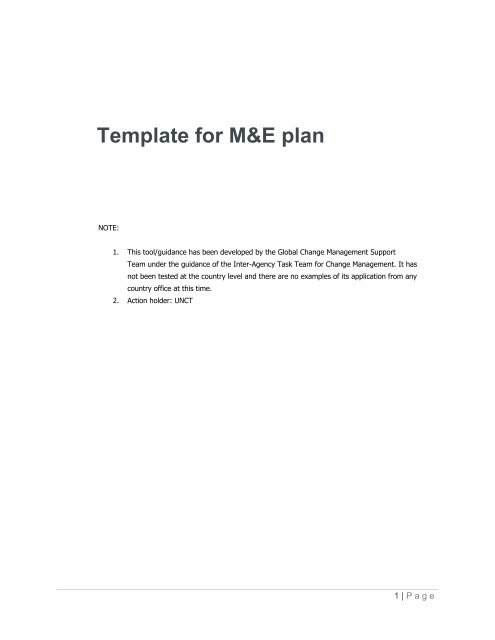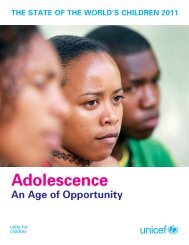Template for M&E plan
Template for M&E plan
Template for M&E plan
You also want an ePaper? Increase the reach of your titles
YUMPU automatically turns print PDFs into web optimized ePapers that Google loves.
<strong>Template</strong> <strong>for</strong> M&E <strong>plan</strong><br />
NOTE:<br />
1. This tool/guidance has been developed by the Global Change Management Support<br />
Team under the guidance of the Inter-Agency Task Team <strong>for</strong> Change Management. It has<br />
not been tested at the country level and there are no examples of its application from any<br />
country office at this time.<br />
2. Action holder: UNCT<br />
1 | P age
Table of Contents<br />
Introduction and Context.……………………………………………………………………….….p.3<br />
Objectives……………………………………………………………………………………………p.4<br />
<strong>Template</strong> M&E <strong>plan</strong>…………..………………………………………………………………….....p.5<br />
2 | P age
1 Introduction and Context<br />
M&E <strong>for</strong> UN Coherence, Effectiveness, and Relevance (CER) is an integral part of the change<br />
initiative, and relevant throughout Steps 3-9. It is based on the results matrices developed in<br />
Step 3. An M&E group should be allocated to each outcome in the results matrices. The M&E<br />
groups should be tasked with developing the M&E <strong>plan</strong>, i.e. the <strong>plan</strong> against which progress will<br />
be monitored and evaluated.<br />
CER is about ensuring real progress towards the MDGs, national development priorities and<br />
other internationally agreed development goals. CER will be pursued through the<br />
implementation of an UNDAF or common programming tool, a common budgetary framework,<br />
common Services and harmonized business practices and common premises where applicable<br />
The template below reflects this and is intended as an aid to UNCTs and M&E groups in<br />
developing the M&E <strong>plan</strong> <strong>for</strong> CER. It shows the structures and elements of such a <strong>plan</strong>. This<br />
tool is best used in combination with<br />
- the sample M&E <strong>plan</strong>s from the pilot countries in the toolkit that provide content<br />
- the M&E guidelines, which give further guidance on how to develop an M&E <strong>plan</strong><br />
3 | P age
2 Objectives<br />
• Support UNCTs and M&E groups in developing the M&E <strong>plan</strong><br />
• Facilitate the development of the M&E <strong>plan</strong> by providing the structure and the template<br />
• Focus the M&E activities of the UNCT and align them more closely with national<br />
mechanisms<br />
• Encourage the UNCT to document what needs to be monitored, with whom, when, how,<br />
and how the M&E data will be used<br />
• Coordinate the different types of studies and evaluations conducted by agencies and<br />
their partners<br />
4 | P age
3 TEMPLATE FOR M&E PLAN<br />
Elements:<br />
1. M&E management <strong>plan</strong><br />
2. M&E Framework<br />
3. M&E Calendar<br />
1. M&E MANAGEMENT PLAN<br />
In this section:<br />
• Describe how the UNCT and partners will undertake and coordinate CER monitoring,<br />
with clear accountabilities <strong>for</strong> agencies and partners; and ef<strong>for</strong>ts to strengthen national<br />
M&E capacities.<br />
• Estimate the human, financial and material resource requirements <strong>for</strong> its<br />
implementation.<br />
• Spell out the TORs <strong>for</strong> interagency working group consisting of agency M&E Officers.<br />
The working group would be responsible <strong>for</strong> tracking and coordinating the<br />
implementation of the M&E <strong>plan</strong> and <strong>for</strong> promoting joint CER monitoring and evaluation.<br />
As a minimum, outcome groups will:<br />
Meet regularly with partners to assess progress towards CER results;<br />
Conduct joint field monitoring missions to gauge achievements and constraints;<br />
Identify any lessons or good practices;<br />
Reflect on how well CER results are addressing human rights and gender equality<br />
concerns;<br />
Identify capacity development needs among partners, particularly related to data<br />
collection, analysis, monitoring and reporting;<br />
Report regularly to the individuals leading the UNCT on the issues listed above, and<br />
help them bring lessons and good practices to the attention of policy makers;<br />
Support UNCT action that assists the Government in reporting to international<br />
human rights bodies on the progress made by the State; and<br />
Prepare one annual progress report, using the M&E <strong>plan</strong> as a template, as an input<br />
to the annual reviews, and to help prepare agency and the Resident Coordinator’s<br />
annual reports.<br />
2. M&E FRAMEWORK<br />
Note on M&E Framework <strong>for</strong> Business Operations:<br />
The monitoring components of the Common services and harmonized business practices,<br />
Common premises (where applicable), Joint Communication and the Common budgetary<br />
framework function at two levels:<br />
1. In addition to identifying/deciding on programmatic outcomes, the UNCT will also<br />
identify/decide on operational outcomes as part of/in conjunction with the UNDAF or<br />
common programming tool vision, mission and results exercise (outcomes largely<br />
supporting the CER objective(s))<br />
5 | P age
2. Interventions will be designed to support the successful achievement of the<br />
programmatic and the operational outcomes. Some of the interventions will support one<br />
outcome only, other interventions will support more than one outcome.<br />
3. For the individual common services and harmonized business practices and common<br />
premises interventions, where applicable, the conceptualizing and <strong>plan</strong>ning stages<br />
include developing per<strong>for</strong>mance/results related Service Requirements (WHAT must the<br />
intervention do <strong>for</strong> the clients) lending itself to easy measuring of whether or not the<br />
WHAT has been achieved (SMART indicators). Furthermore, the <strong>plan</strong>ning process<br />
include the development of an implementation <strong>plan</strong> complete with the HOWs, milestones,<br />
budgets, reporting, review schedules etc. Note that these indicators, milestones etc. etc.<br />
only connect indirectly to the overall outcomes.<br />
TEMPLATE <strong>for</strong> Monitoring and Evaluation Framework (NOTE: You will need to use your<br />
Results Matrix developed in Step 3 as a basis. Compare example of Tanzania <strong>for</strong> further<br />
guidance)<br />
Outcome 1 (UNDAF or common programming tool): ....<br />
Output Indicator Baseline Target Source of<br />
verification<br />
1.1. …<br />
(United<br />
Nations)<br />
…<br />
…<br />
…<br />
…<br />
1.x ....(Agency<br />
y)<br />
Assumption/Risk<br />
Outcome 2 (UNDAF or common programming tool): ....<br />
Output Indicator Baseline Target Source of<br />
verification<br />
2.1 ....<br />
(United<br />
Nations)<br />
...<br />
...<br />
...<br />
...<br />
2.x ...<br />
(Agency z)<br />
Assumption/Risk<br />
Outcome n (UNDAF or common programming tool): ...<br />
6 | P age
Output Indicator Baseline Target Source of<br />
verification<br />
n.1 (United<br />
Nations)<br />
...<br />
...<br />
...<br />
...<br />
n.x<br />
(Agencies<br />
x,y,z)<br />
Assumption/Risk<br />
Additional outcome : ‘By 20x the country will have increased the coherence,<br />
effectiveness and relevance of UN service delivery through the channels of a UN<br />
common budgetary framework, common services and harmonized business practices,<br />
and common premises, where applicable’<br />
Output Indicators Baseline Target Source of Assumption/Risk<br />
verification<br />
Common<br />
services and<br />
harmonized<br />
business<br />
practices<br />
Common<br />
premises<br />
Common<br />
budgetary<br />
framework<br />
3) M&E CALENDAR (Compare Example of Angola)<br />
The M&E calendar improves the coordination and use of M&E activities. The calendar provides<br />
a schedule of all major M&E activities. It describes agency and partner accountabilities, the<br />
uses and users of in<strong>for</strong>mation, the evaluation milestones, and complementary partner activities<br />
TEMPLATE: The M&E Calendar<br />
3.1.1.1.1.1 YYear<br />
1 Year 2 Year 3 Year<br />
4<br />
Year 5<br />
7 | P age
UNCT M&E activities 1<br />
Planning references<br />
Surveys/studies<br />
Monitoring<br />
systems<br />
Evaluations<br />
Reviews<br />
Evaluation<br />
milestones<br />
M&E capacity<br />
development<br />
Use of<br />
in<strong>for</strong>mation<br />
Partner Activities<br />
Investigations of a problem or assessments of the conditions of<br />
a specified population group. They can help to identify root<br />
causes, and findings are used to develop or refine programme<br />
strategy and/or define baseline indicators.<br />
Typically this will include UNCT support to national in<strong>for</strong>mation<br />
systems, with regular and fairly frequent reporting of data<br />
related to CER results. In particular it should include UNCT<br />
support <strong>for</strong> national reporting to Human Rights treaty bodies.<br />
An evaluation attempts to determine objectively the worth or<br />
significance of a development activity, policy or programme.<br />
This section includes all evaluations of agency programmes<br />
and projects contributing to CER, and the CER evaluation<br />
Reviews will generally draw on agency and partners’<br />
monitoring systems as well as the findings of surveys, studies<br />
and evaluations<br />
Timing and sequence of the milestones in preparing and<br />
implementing the CER Evaluation. These should make use of<br />
the M&E activities above.<br />
A list of the major, <strong>plan</strong>ned capacity development activities to<br />
strengthen partner M&E capabilities.<br />
Any decision-making processes or events that will draw on the<br />
findings, recommendations and lessons from the M&E activities<br />
above. For example: national or international conferences,<br />
MDG reporting, reporting to human rights bodies, preparation<br />
of the national development framework, the prioritization<br />
exercise, and preparation of CER.<br />
The major M&E activities of Government and other partners<br />
that use and/or contribute to the M&E activities above.<br />
1 For each activity list: Short name of activity; focus vis-à-vis results; agencies/partners responsible; timing.<br />
8 | P age
















